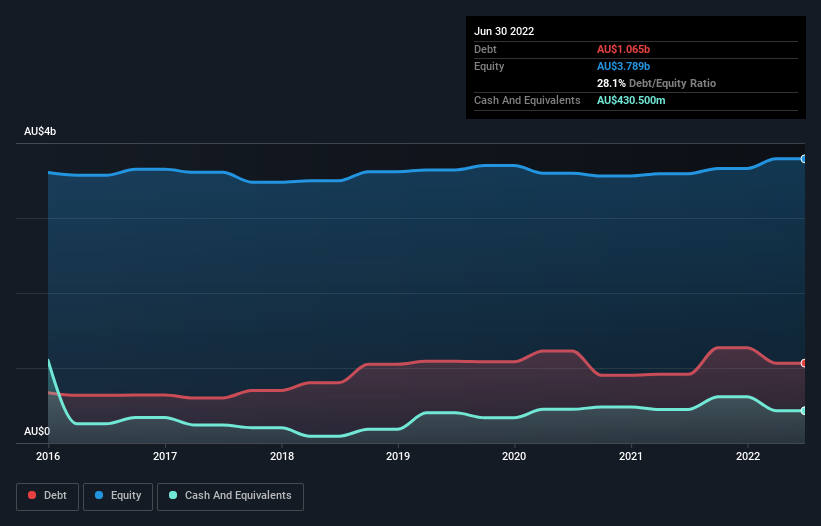Does Treasury Wine Estates (ASX:TWE) Have A Healthy Balance Sheet?
David Iben put it well when he said, 'Volatility is not a risk we care about. What we care about is avoiding the permanent loss of capital.' So it might be obvious that you need to consider debt, when you think about how risky any given stock is, because too much debt can sink a company. We note that Treasury Wine Estates Limited (ASX:TWE) does have debt on its balance sheet. But is this debt a concern to shareholders?
Why Does Debt Bring Risk?
Debt is a tool to help businesses grow, but if a business is incapable of paying off its lenders, then it exists at their mercy. In the worst case scenario, a company can go bankrupt if it cannot pay its creditors. However, a more common (but still painful) scenario is that it has to raise new equity capital at a low price, thus permanently diluting shareholders. By replacing dilution, though, debt can be an extremely good tool for businesses that need capital to invest in growth at high rates of return. The first step when considering a company's debt levels is to consider its cash and debt together.
See our latest analysis for Treasury Wine Estates
What Is Treasury Wine Estates's Net Debt?
You can click the graphic below for the historical numbers, but it shows that as of June 2022 Treasury Wine Estates had AU$1.06b of debt, an increase on AU$915.2m, over one year. On the flip side, it has AU$430.5m in cash leading to net debt of about AU$634.2m.

A Look At Treasury Wine Estates' Liabilities
We can see from the most recent balance sheet that Treasury Wine Estates had liabilities of AU$1.00b falling due within a year, and liabilities of AU$1.87b due beyond that. Offsetting this, it had AU$430.5m in cash and AU$515.1m in receivables that were due within 12 months. So its liabilities outweigh the sum of its cash and (near-term) receivables by AU$1.93b.
Given Treasury Wine Estates has a market capitalization of AU$9.90b, it's hard to believe these liabilities pose much threat. Having said that, it's clear that we should continue to monitor its balance sheet, lest it change for the worse.
We measure a company's debt load relative to its earnings power by looking at its net debt divided by its earnings before interest, tax, depreciation, and amortization (EBITDA) and by calculating how easily its earnings before interest and tax (EBIT) cover its interest expense (interest cover). This way, we consider both the absolute quantum of the debt, as well as the interest rates paid on it.
Treasury Wine Estates has net debt of just 1.1 times EBITDA, indicating that it is certainly not a reckless borrower. And this view is supported by the solid interest coverage, with EBIT coming in at 7.2 times the interest expense over the last year. Fortunately, Treasury Wine Estates grew its EBIT by 4.6% in the last year, making that debt load look even more manageable. When analysing debt levels, the balance sheet is the obvious place to start. But it is future earnings, more than anything, that will determine Treasury Wine Estates's ability to maintain a healthy balance sheet going forward. So if you're focused on the future you can check out this free report showing analyst profit forecasts.
But our final consideration is also important, because a company cannot pay debt with paper profits; it needs cold hard cash. So it's worth checking how much of that EBIT is backed by free cash flow. Over the most recent three years, Treasury Wine Estates recorded free cash flow worth 68% of its EBIT, which is around normal, given free cash flow excludes interest and tax. This free cash flow puts the company in a good position to pay down debt, when appropriate.
Our View
Happily, Treasury Wine Estates's impressive conversion of EBIT to free cash flow implies it has the upper hand on its debt. And we also thought its net debt to EBITDA was a positive. Looking at all the aforementioned factors together, it strikes us that Treasury Wine Estates can handle its debt fairly comfortably. On the plus side, this leverage can boost shareholder returns, but the potential downside is more risk of loss, so it's worth monitoring the balance sheet. Above most other metrics, we think its important to track how fast earnings per share is growing, if at all. If you've also come to that realization, you're in luck, because today you can view this interactive graph of Treasury Wine Estates's earnings per share history for free.
If you're interested in investing in businesses that can grow profits without the burden of debt, then check out this free list of growing businesses that have net cash on the balance sheet.
Valuation is complex, but we're here to simplify it.
Discover if Treasury Wine Estates might be undervalued or overvalued with our detailed analysis, featuring fair value estimates, potential risks, dividends, insider trades, and its financial condition.
Access Free AnalysisHave feedback on this article? Concerned about the content? Get in touch with us directly. Alternatively, email editorial-team (at) simplywallst.com.
This article by Simply Wall St is general in nature. We provide commentary based on historical data and analyst forecasts only using an unbiased methodology and our articles are not intended to be financial advice. It does not constitute a recommendation to buy or sell any stock, and does not take account of your objectives, or your financial situation. We aim to bring you long-term focused analysis driven by fundamental data. Note that our analysis may not factor in the latest price-sensitive company announcements or qualitative material. Simply Wall St has no position in any stocks mentioned.
About ASX:TWE
Treasury Wine Estates
Operates as a wine company in Australia, the United States, the United Kingdom, and internationally.
Very undervalued with solid track record and pays a dividend.
Similar Companies
Market Insights
Community Narratives




